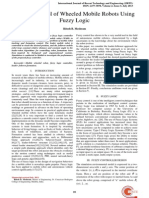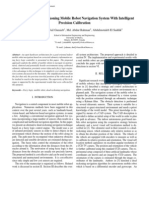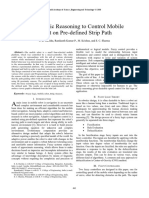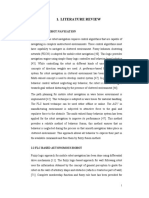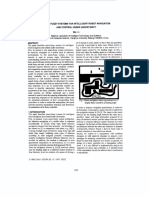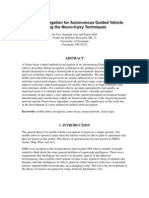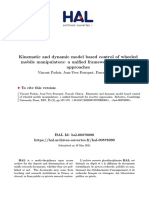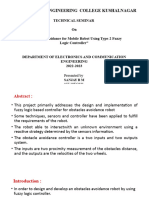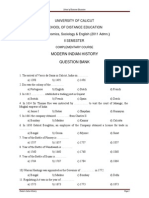0 ratings 0% found this document useful (0 votes) 24 views 7 pages Fuzzy Logic Navigation and Obstacle
Fuzzy Logic Navigation and Obstacle
Copyright
© © All Rights Reserved
We take content rights seriously. If you suspect this is your content,
claim it here .
Available Formats
Download as PDF or read online on Scribd
Go to previous items Go to next items
Save Fuzzy Logic Navigation and Obstacle For Later creck rues,
INTECH
ce scan |apernes
OPEN 38 ACCESS
ARTICLE
International Journal of Advanced Robotic Systems
Fuzzy Logic Navigation and Obstacle
Avoidance by a Mobile Robot in
an Unknown Dynamic Environment
Regular Paper
Mohammed Faisal'”, Ramdane Hedjar', Mansour Al Sulaiman’ and Khalid Al-Mutib’
1 College of Computer and Information 5
* Corresponding author -mail mfasal@ksu.edusa
Received 26 Apr 2012; Accepted 16 Oct 2012
ok: 10.8772/84427
5, King Saud Univers,
soul Arabia
(© 2013 Fasal eta; Icensee InTech. Thi isan open access article distributed under the terms ofthe Creative
Commans Attrbution Leense thio ereaivacommans.orgfcensesby/3.0), which permis unvesvicled se,
strbution, and reproduction inary mecium, provided the original works properly ited.
Abstract Mobile robot navigation has remained an open
problem over the last two decades, Mobile robots are
required to navigate in unknown and dynamic
environments, and in recent years the use of mobile
robots in material handling has considerably increased.
Usually workers push carts around warehouses and
manually handle orders which is not very cost-effective.
To this end, a potential method to control a swarm of
mobile robots in a warehouse with static and dynamic
obstacles is to use the wireless control approach.
Further, to be able to control different types of mobile
robots in the warehouse, the fuzzy logic control
approach has been chosen. Therefore, in this paper, an
omline navigation technique for a wheeled mobile robot
(WMR) in an unknown dynamic environment using,
fuzzy logic techniques is investigated. In this paper, we
aim to use the robot in application in a warehouse.
Experimental results show the effectiveness of the
proposed algorithm,
Keywords Fuzzy Logic Control, Wheeled Mobile
Robot, Wireless Communication, Navigation and
Obstacles
vwonnechopen com
1 Introduction
‘Many researchers have anticipated that mobile robots,
‘will take charge in various tasks in manufacturing plants,
‘warehouses and construction sites. Recently, the use of
mobile robots in material handling applications has
‘considerably increased. For instance, in warehouses,
‘mobile robots are used for material handling from
stockrooms and also monitoring the inventory of
different items in the warehouse. For this reason, wireless
communication control is adequate for the motion and.
navigation of a set of mobile robots inside a covered
space. Indeed, wireless controls of a swarm of mobile
robots offer good features: self-organization, flexibility,
improvement in production quality and cost savings.
Moreover, wireless navigation control of a set of mobile
robots in a warehouse is better than the coloured line
tracking method used in most of old warehouse systems.
‘The fuzzy logic control does not need the mathematical
model of the controlled process. This will permit
controlling vehicles with different mathematical models,
In this work, two fuzzy logic controllers (ELCs), using.
different membership functions, are used for mobile�robot navigation in an unknown environment. A
Tracking Fuzzy Logic Controller (IFLC) is employed to
navigate the WMR to its target. An Obstacles Avoiding
Fuzzy Logic Controller (OAFLC) is proposed to perform
the obstacle behaviour. The dynamic
environment and the insufficient information on the
environment are the main challenge in the navigation
operation of the WMR, The traditional mobile robot
planning approaches remain not robust and unable to
overcome these challenges. As a result, many reactive
approaches were introduced allowing the use of artificial
intelligence techniques, where problem solving, learning
land reasoning are the main issues, Within this scope,
fuzzy logic [5, 6, 7, neural networks [2, 3, 4] and other
artificial intelligence techniques, became the basis of
navigation systems in mobile robots,
avoidance
Over the last two decades, many motion control methods
have been proposed for efficient movement of Wheeled
Mobile Robot (WMR). Despite the advances in the field of
autonomous robotics, many problems still exist. Most of
the difficulties are due to dynamic
environments, Various useful techniques, such as fuzzy
logic, genetic algorithms and neural networks are used to
deal with unknown and dynamic environments,
unknown
Many researchers have used fuzzy logic techniques in the
navigation of WMR, The research proposed in [13] is
related to mobile robot navigation in which both target and
obstacle avoidance are treated. ‘The approach uses a
‘method that the authors named FIM. Although the idea is
‘good, it needs an optimized rule based which is obtained
using a genetic algorithm. The research proposed in [17]
uses hybrid approaches, ie, a fuzzy logic system with
multiple types of input, which are sonar, camera and
stored map. This paper lacks simulation and
experimentation, so we cannot effectively evaluate this
scheme. On the other hand, we do not have any idea on the
real-time operation due to the fact that the authors use
many sensors to sense the surrounding environment
Indoor navigation using fuzzy logic has been presented in
[12}-The authors proposed how to use F.C for the target
‘tracking control of WMRs, The authors of (1
any FLC to avoid the obstacles, they just use FLC for
motion, Another indoor navigation system using fuzzy
logic is presented in [16}.The authors used the fuzzy logic
and visual sensors to guide the robot to its target. But this
scheme does not use any FLC to avoid the obstacles; it just
uses FLC for WMR motion. In [8], the authors have
presented a navigation approach for several mobile robots
in an unknown environment using the fuzzy logic
technique. In this work, the authors used a fuzzy logic
controller (FLC) with a different number of membership
functions — (three-membership
‘membership function) to navigate the mobile robots in an
unstructured environment. A realtime fuzzy target
tracking control scheme for autonomous mobile robot
function and five
Int A Robotic, 203, Val. 10, 372013
using infrared sensors is presented in (10), It uses two
robots, the first WMI is the moving target and the second
is the tracker. In [11], the authors have presented a control
structure that combines a kinems
adaptive fuzzy controller for trajectory tracking, Wireless
communication has been used in mine rescue and recovery
[14], Moreover, fuzzy logic control combined with wireless
communication can be useful to control a swarm of WBRs
utilizing only one server as a controller or as a supervisor.
In this work, this strategy has been adopted for wireless
fuzzy logic contzol of a WMR,
ic controller and an
‘This paper is organized as follows. In Section 2, a
kinematics model of the WMR is presented. To estimate
the configuration of the WMR at each sampling time, dead.
reckoning is addressed in section 3. Section 4 depicts the
proposed fuzzy logic control for tracking and navigation.
In section 5, the wireless communication used in this work
is discussed, Experimental results aregiven in section 6,
‘The conclusion and suggestions are given in section 7.
2. Kinematics Model of WMR
The mobile robot used in this work is a unicycle type
mobile robot (figure 1). The WMR contains two
individual driving wheels mounted at the front of the
chassis on the same axis and the third free wheel (castor
wheel) on the back of the chassis to balance the mobile
robot during motion, ‘These two wheels are
independently driven by two actuators to achieve the
motion and orientation. The kinematics model of this
kind of mobile robot is described by the following
nonlinear equations (1)
Figure 1. Geometric description ofthe WM,
9 = vsin (8) @
6 = ve0s (8)
4
where x and y are the coordinates of the position of the
mobile robot. 8 is the orientation of the mobile robot with
respect the positive direction X-axis. v is the linear
velocity and « is the angular velocity.
3, Dead-Reckoning
Dead-reckoning is used to estimate the position and
orientation of a WMR during motion, The dead-
vac techopen com�reckoning method is based on the previous position and
orientation at time f= ti: to calculate the next position and
orientation at ft. Using the Euler approximation,
equation (1) becomes:
x(k +1) = x(H) + v4) T, cos (0(K))
yk +1) = ¥0) + (8) T, sin(@0)
Ok +1) = 0H) + wT
@
where T; = teas — fis the sampling time. Itis preferable
to use the distance travelled by the mobile robot during
T. and this can be calculated using pulses of the encoders
fon each motor of the robot DC wheel. This mathematical
_model is described by the following equations:
eposrtary)
x(k + 1) = x(k) + PETA cos (0(K))
yk 1) = 9) + 2 sn 0) @)
ok +1) = 00g + 22Teste
where AT = Tysx — Th are the impulses of the encoders (L.
stands for left and R stands for right) during the sampling
rate T,, dst is the distance between the wheels, D is the
diameter of wheels, and Tw is the number of encoder
pulses for full rotation.
Tt is known that this method is not accurate for fast dynamic
motion of a WMR. However, as stated in [I], the accuracy is
acceptable for low dynamics motion of a WMR, Thus, in the
experimental part, low dynamic motion of the WMR is
adopted in order to use the dead-reckoning algorithm to
estimate the actual configuration of the mobile robot.
4. Fuzzy Logie Control
‘Two fuzzy logic controllers are developed and used to
navigate the mobile robot from the initial configuration to
the goal. Tracking fuzzy logic control (TFLC) and obstacle
avoidance fuzzy logic contzol (OAFLC) are combined to
move the mobile robot to the target along a collision free
path. In this work, the algorithm starts with TFL. If
sensors detect any obstacles inthe front of the robot, then.
the control algorithm switches over to the OAFLC. The
output of TELC and OAFLC are the left and right
velocities of each wheel. Figure 2 illustrates the fuzzy
controller of TELC and OAFLC,
4.1 TFLC
‘TFLCis proposed to move the WMR to is target smoothly.
‘The inputs of TFLC are the angle between the robot and
the target (eror angle), and the distance From the robot to
the target. The outputs of TFLC are the velocities ofthe let
and right motors. TFLC is implemented with seven
membership functions for each input a5 illustrated in
figures 3 and 4. The linguistic variables used forthe angle
between the robot and the target (Ere. angle) are: Ni
Negative, SN: Small Negative, NNZ: Near Negative Zero,
woimechopen com
Fuzzy Lege Navigation
7: Zero, NPZ: Near Positive Zero, SP: Small Positive and P:
Positive. The linguistic variables used for input distance
are: Z: Zero, NZ: Near Zero, N: Near, M: Medium, NF
Near Far, F: Far and VE: Very Far.
Le ange {N, SN, NNZ, Z, NPZ, SP, P}
Lovsanee= {Z, NZ, N, M, NE, FE, VE}
‘TFLC is implemented with seven membership functions
for each output (Left Velocity LV and Right Velocity RV
cof the motors) as illustrated in figure 5. The linguistic
variables used for the fuzzy rules of TFLC are: Z: Zero, S:
Slow, NM: Near Medium, M: Medium, NH: Near High,
H: High and VE: Very High. The membership functions
{for the left and the right motors are shown in table 1.
Luw=L#w{Z, 8, NM, M, NH, H, VH}
=
‘pens Tors 7
———
Renderer ate
Dead echoing Te
Sos
esd oars vrs
Yo ras desing ay [renee —
asas*| |RSS cc
Figure 3. Membership functions for the distance
tack Avedarce oj + Mabie Robot in an Unenoun Dynamic�Figure 4, Membership functions forthe error in angle
Figure 5. Membership functions forthe left and right velocity
ps if
ran | aan] sm [ca
Table 1, Fuzzy rules ofthe let velocity and right velocity of the
motors in TFLC
The velocities (LV and RV) of the driving wheels of the
robots are calculated using the defuzziication step. Note
that in this work the weighted average defuzzification
technique has been adopted.
Further, if an obstacle is detected around (from 0° to 180°)
the mobile robot, the control algorithm switches over to
the OFLC,
4.2 OAFLC
OAFLC is proposed to generate a control signal (LV and
LR) in order to avoid obstacles in unknown dynamic
environments, The inputs of OAFLC are the distance
between the left, front and right sides distances of the
robot and the obstacles. These distances are acquired by
three ultra-sonic sensors, from the leit, front and right
side of the robot. The outputs of OAFLC are the velocities
of the left and right motors, OAFLC is implemented with
three membership functions for each input as illustrated
{in figure 6, The linguistic variables used for the distance
Int A Robot y, 2013, Val. 10, 372013
between the robot and obstacles (LD, RD, and FD) are: N:
Near, M: Medium and Far
Lin=Lm-L ao=(N, M,F),
Figure 6 Left, front and right obstacle distance.
[Figure 7. Membership functions for the LV and RV of OAFLC
For the outputs, OAFLC is implemented with five
membership functions for each output (left velocity LV
and right velocity RV) as illustrated in figure 7. The
linguistic variables used for the fuzzy rules of OAFLC
are: NH: Negative High, N: Negative, P: Positive, HP:
High Positive and VHP: Very High. ‘The linguistic
variables used for the outputs using five membership
functions for left and right motor are shown in table 2,
Luy=Lav={NH,N, P, HP, VHP}
Ta Saat
i 7D om cy Ty
N N. WN NE NE
x N. Me a NEL
x N. F N NE
N, cs N, NE NEC
S x x x NE
x x F x Nit
x F. N. iE Ni
x F Me NEL
x F F a NEL
Mt N. N. NE N
Mt a Ww P wir
wt co we VHP
Mt x F VHP! r
Mt N. NEE x
Mt F Me VHP F
F, N. x P wir
F N. F. i Nit
F xt N. NE N.
F x Me P War
F x F THF F
F F F a HP
‘Table 2. The fuzzy rules forthe left and right velocities ofthe
OAFLC.
oa techopen com�5, Wireless Communication
This work aims to navigate the robot in a warehouse.
Wireless communication is a plausible solution for swarm
mobile robots used for material handling in 2 warehouse,
We use the ScoutIl as a WMR, which is a wireless
network robot, It connects to the wireless AP oF router via
IEEE 802.116/g, with high bandwidth (11Mbps) [15]
Using such a bandwidth, ScoutII could send all sensor
data (including encoder sensor readings) to a server at
rates of 10HzThe server PC, which runs the Scoutl
control program, connects (0 this network via either
network cable or wireless. Figure 8 illustrates the operation
scenario of Scoutll. There are many benefits of using
wireless technology to control the motion of 2 WMR:
‘wireless deployment is less expensive than the use of wires
due to wire replacement and increased congestion.
Wireless is more efficient in terms of scalability, the current
‘bandwidth is suitable for data communication, which is
required to contzol the motion of the WMR.
6. Experimental results
‘The used mobile robot platform is the Scout robot
developed by Dr Robot Inc [15]. The Scout-ll is a
differentia-drive robot for research, Scoutll is “a ready
to use mobile robot platform designed for remote
monitoring patrolling” [15]. Scoutll uses Wi
(802:11b/g) as an interface for the wireless
communication. In this work, wireless communicates
effectively up until the range of 213 feet (56 metres) in an
indoor environment. In addition, it uses C+ interface as a
programming language. In the experiment part, the
parameters used are: dsi= 305 em, D =17 cm and
Te 800 pulses for full rotation.
‘The experiment part of this work is divided in three
scenarios. In the first scenario, the mobile robot navigates
Jn an unstructured environment without obstacles, as
illustrated in figure 9. In the second scenario, the mobile
robot Scout-ll navigates in an unstructured environment
‘with four static obstacles, as illustrated in figure 10. These
obstacles have different shapes, three are rectangular and
fone is circular. In the third scenario, the mobile robot
woimechopen com
Fuzy Lege Navigaton a
navigates in a dynamic environment as illustrated in
figure 13, Let us assume that we need to move the robot,
from the initial point to the goal as shown in table 3.
‘These points are used for all scenarios. Note that in this,
work, we are not interested in the final configuration with
orientation, Thus, @ is not included in table 3.
Points
Thiel Oem Dem
Thermediate 150 em 150m
Target 15am 00m |
‘Table 3. Movement points
Figures 9 and 10 illustrate the path performed by the
‘mobile robot Scout-ll to reach the target, The generated.
ppath to the target is relatively smooth. Notice that the
robot turns gradually first toward the intermediate point
and secondly towards the target. The robot speed varies
with respect to its angle velocity as defined by the fuzzy
logic controller. Note that this data are generated using a
‘dead-reckoning algorithm. As mentioned in [1], when the
speed of the mobile robot is slow, the algorithm provides
accurate position and orientation for the robot.
g
xiem)
Figure 9. First scenario (environment without obstacles).
“
= t
a al
ee
50 x ae 750 ~—« 200 «50
Figure 10, Second scenari (environment with obstacle).
ack Avedon
3 Mobile Rtotin am Unerown Dynamic�In all scenarios, the robot moves from the initial point to
the intermediate point, then from the intermediate point
to the target point, In the second scenario, four obstacles
have been added to the scene. As shown in figure 10, if
the distance between the obstacle and robot sonar
mounted on the robot's left, front and right sides is less
than 70 em, then the robot motion control switches from
the TFLC algorithm to the OAFLC algorithm in order to
avoid the obstacle. Figure 11 illustrates the real-time
experimental results of the environment scenario without
obstacles
[As we can see from figures 9 and 10, the motion of the
robot in the first scenario is different from the motion in
the second scenario. This difference comes from the
obstacles which are present in the environment in the
second scenario.
Figure 12 illustrates the real-time experimental results of
the second scenario, where obstacles are added to the
environment, Figure 12 shows the Scout-II robot passing
‘through the obstacles. The generated path in figure 9
corresponds to the real experimentation given in figure
11. The generated path shown in figure 10 corresponds to
‘the real experimentation of figure 12.
Figure 13 illustrates the behaviour of the robot within the
dynamic obstacles. As shown in figure I3-a, the dynamic
obstacle moved in front of the robot and the robot
responded to that dynamic obstacle by switching the
control scheme from TFLC to OAFLC, passing by it as
illustrated in figure 13-b.
Since only one robot is available in the laboratory, we
have used a researcher as a moving obstacle in the scene.
‘Tne WMR was able to avoid both the researcher and
other static obstacles, This scenario was performed so as
to.be close to the real scene in a warehouse.
Figure 11 Fest scenario (during navigation).
Int A Robot y, 2013, Val. 10, 372013
Figure 13-a. Third scenario (dynamic obstacies)
[igure 13-b, Third scenario (pass by dynamic obstacle)
Note to the readers, videos for all scenarios are available
in the following links:
_http://www youtube.com/watch?v-FQafywftJd8&feature
routu.be
‘The link of the second scenario is:
|http:/www.youtube.com/watch?v-ABo_IVLH)n0&featur
e-youtube
‘The third scenario
|ttp:/www.youtube.com/wateh?
youtube
lUngxnddVsSeteature
vac techopen com�7. Conclusion
In this paper, we have proposed a wireless fuzzy logic
control of a wheeled mobile robot (unicycle type). The
proposed work intends to introduce mobile robots for
‘material handling in warehouse environments where
wireless communication is used instead of coloured line
tracking that complicates the navigation of a swarm of
mobile robots.
Experimental part has been performed on one available
mobile robot (Scout-I) and so as to be as close to the
scene in warehouse a5 possible, a researcher has been
used as a moving obstacle. According the experimental
results, the extension to a set of mobile robots can easily
be done. Further, experimental results have validated the
proposed algorithm and smooth paths have been
generated by using the fuzzy logic algorithm in
structured and unstructured environments.
For future work, the proposed wireless contral of a WMR
should be extended to a swarm of mobile robots. Analysis
of the influence of induced time delay from the wireless
communication of the networked mobile robots is worthy
of further investigation.
8, Acknowledgments
‘This work is supported by the NPST programme at King
Saud University (project no. :08-ELE-300-02),
9, References
[1] G. Oriol, A. Deluca and M. Vendittelli, (2002)
“WME control via dynamic feedback linearization:
design, implementation and experimental
validation,” IEEE Trans, On Control Systems
Tehmology, Vol.10, No.6, pp. 835-852.
[2]. B. Kosko (1992),Neural Network and Fuzzy Systems:
A Dynarsical Systems Approach to Machine Intelligence.
Prentice Hall International, Inc
[3] R. Carel, E. F. Camacho, D. Patifio (1995),“A neural
network based feed forward adaptive controller for
robot,” IEEE Trans. Syst, Man, Cybern, vol. 5, no. 9,
pp. 1281-1288.
[4] FL. Lewis, S. Jagannathan, A. Yesildirek (1999)
Neural Network Control of Robot Manipulators and
Nonlinear Systems, London, U.K. Taylor Francis.
[5] LA. Zadeh (1965) “Fuzzy Sets,” Information and
Control, vol, pp. 29-44
woimechopen com
Fuzy Lege Navigation
[6] L.A. Zadeh (1973) “Outline of a new approach to the
analysis of complex systems and decision process”,
IEEE, Trans Syst, Man, Cybern.,vol3, pp. 28-44
[7] D. Driankoy, H. Hellendourn M. Reinfrank (1993),An
Introduction to Fuzzy Control, Springer-Verlag, Berlin
Heidelberg, New York.
[8] S. Kumar Pradhan, D. Ramakrushna Parhi, A. Kumar
Panda (2009),"Fuzzy logic techniques for navigation
of several mobile robots,” Applied Saft Computing, vol.
9, n0.1, pp. 290-30,
[9] T.H. Lee, H.K. Lam, FH. F. Leung and PK. S. Tam,
(2003),"A practical fuzzy logic controller for the path,
tracking of wheeled mobile robots,” IEEE Control
Systems Magazine, pp 60-65
[10] T. H. S. Li, $4. Chang and W. Tong (2004),"Fuzzy
target tracking control of autonomous robots by:
using infrared sensors", IEF on Fuzzy Systems,
vol.12, no4, pp.491-501
[)T. Das and N, Kan (2006) "Design and
implementation of an adaptive fuzzy logic-based
controller for wheeled mobile robots", IEEE om
Control Systems Tecknlogy, vol.1d, 03, pp 501-510.
[12] R. Rashid, I. Flamvazuthi, M. Begam and M, Arrofiq,
“Differential Drive Wheeled Mobile Robot (WMR)
Control Using Fuzzy Logic Techniques,” AMS "10,
Proceedings of the 2010 Fourth Asia International
Conference on Mathematical/Analytical Modeling and
Computer Simulation 2010, pp. 1-55.
[13] F Abdessemed, K. Benmahamed and E. Monacelli
(2004), “A fuzzy-based reactive controller for a non-
holonomic mobile robot", Robotics and autonomous
Systems, volA7, pp.3l-A6.
[14] RR. Murphy, J. Kravitz and S, L. Stover, “Novel
application of robotics: Mobile robots in mine rescue
and recovering”, JEEE Robotics & Automation
Magazine, June 2008, pp.91-103.
[15] "Wireless Networked Autonomies Mobile Robot with
high Resolution Pan-Tilt-Zoom CCD Camera”, i90 “Dr
Robot Quick-start Guide”. Available Online at:
http://www drrobot.com/products/item downloads)
Scout2_l.pdf, (Accessed 2012 April 5),
[16] V. Raudonis, R. Maskeliunas (2011) “Trajectory based
fuzzy conteoler for indoor navigation”, Computational
Intelligence and Informatics (CINTD. pp. 49-72.
[17] M. Cao and E. L. Hall, "Fuzzy logic control for an
automated guided vehicle,” Intelligent Robots and
Computer Vision XVI: Algorithms, Techniques and
Active Vision, vol. 8522, no. 1, pp. 303-312, 1998,
tack Aveidarce oj + Maile det in an Unenann Dynamic nionment



